Abstract
1. In ten normal volunteers, a transcranial magnetic or electric stimulus that was subthreshold for evoking an EMG response in relaxed muscles was used to condition responses evoked by a later, suprathreshold magnetic or electric test shock. In most experiments the test stimulus was given to the lateral part of the motor strip in order to evoke EMG responses in the first dorsal interosseous muscle (FDI). 2. A magnetic conditioning stimulus over the hand area of cortex could suppress responses produced in the relaxed FDI by a suprathreshold magnetic test stimulus at interstimulus intervals of 1-6 ms. At interstimulus intervals of 10 and 15 ms, the test response was facilitated. 3. Using a focal magnetic stimulus we explored the effects of moving the conditioning stimulus to different scalp locations while maintaining the magnetic test coil at one site. If the conditioning coil was moved anterior or posterior to the motor strip there was less suppression of test responses in the FDI. In contrast, stimulation at the vertex could suppress FDI responses by an amount comparable to that seen with stimulation over the hand area. With the positions of the two coils reversed, conditioning stimuli over the hand area suppressed responses evoked in leg muscles by vertex test shocks. 4. The intensity of both conditioning and test shocks influenced the amount of suppression. Small test responses were more readily suppressed than large responses. The best suppression was seen with small conditioning stimuli (0.7-0.9 times motor threshold in relaxed muscle); increasing the intensity to motor threshold or above resulted in less suppression or even facilitation. 5. Two experiments suggested that the suppression was produced by an action on cortical, rather than spinal excitability. First, a magnetic conditioning stimulus over the hand area failed to produce any suppression of responses evoked in active hand muscles by a small (approximately 200 V, 50 microsecond time constant) anodal electric test shock. Second, a vertex conditioning shock had no effect on forearm flexor H reflexes even though responses in the same muscles produced by magnetic cortical test shocks were readily suppressed at appropriate interstimulus intervals. 6. Small anodal electric conditioning stimuli were much less effective in suppressing magnetic test responses than either magnetic or cathodal electric conditioning shocks.(ABSTRACT TRUNCATED AT 400 WORDS)
Full text
PDF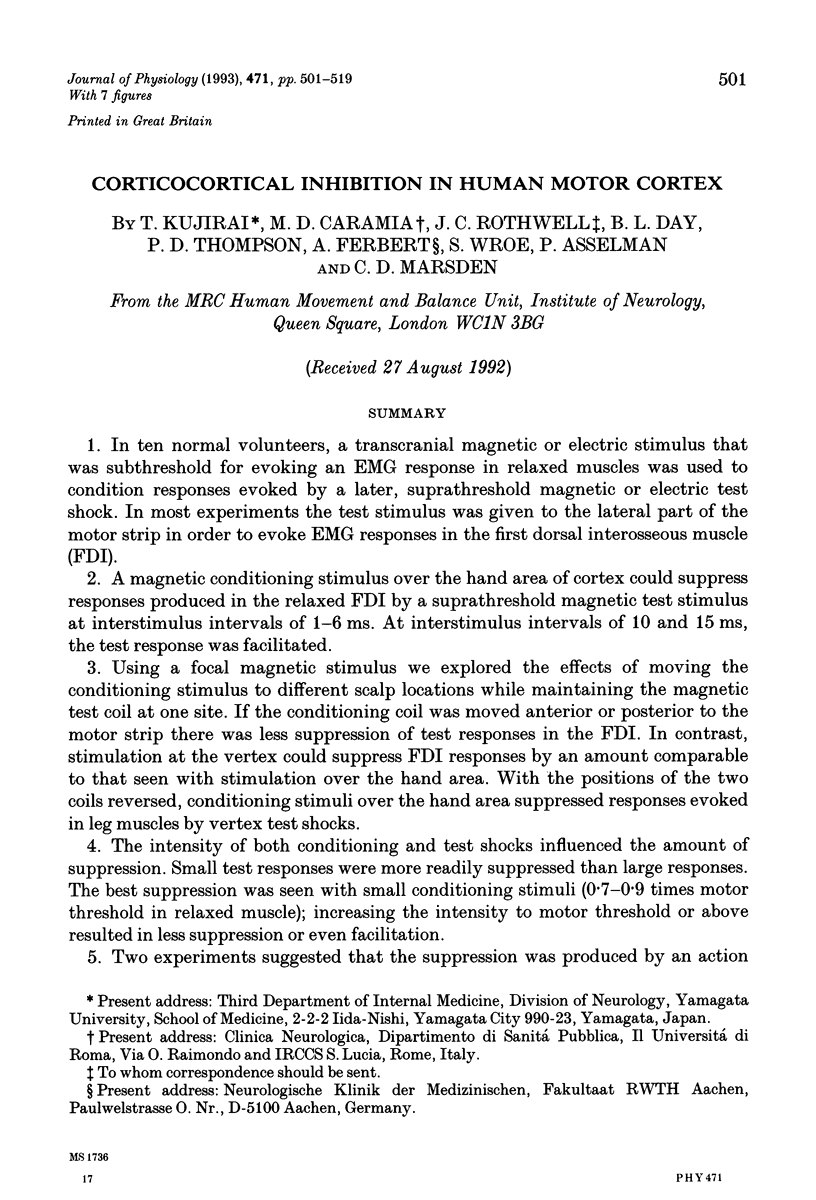
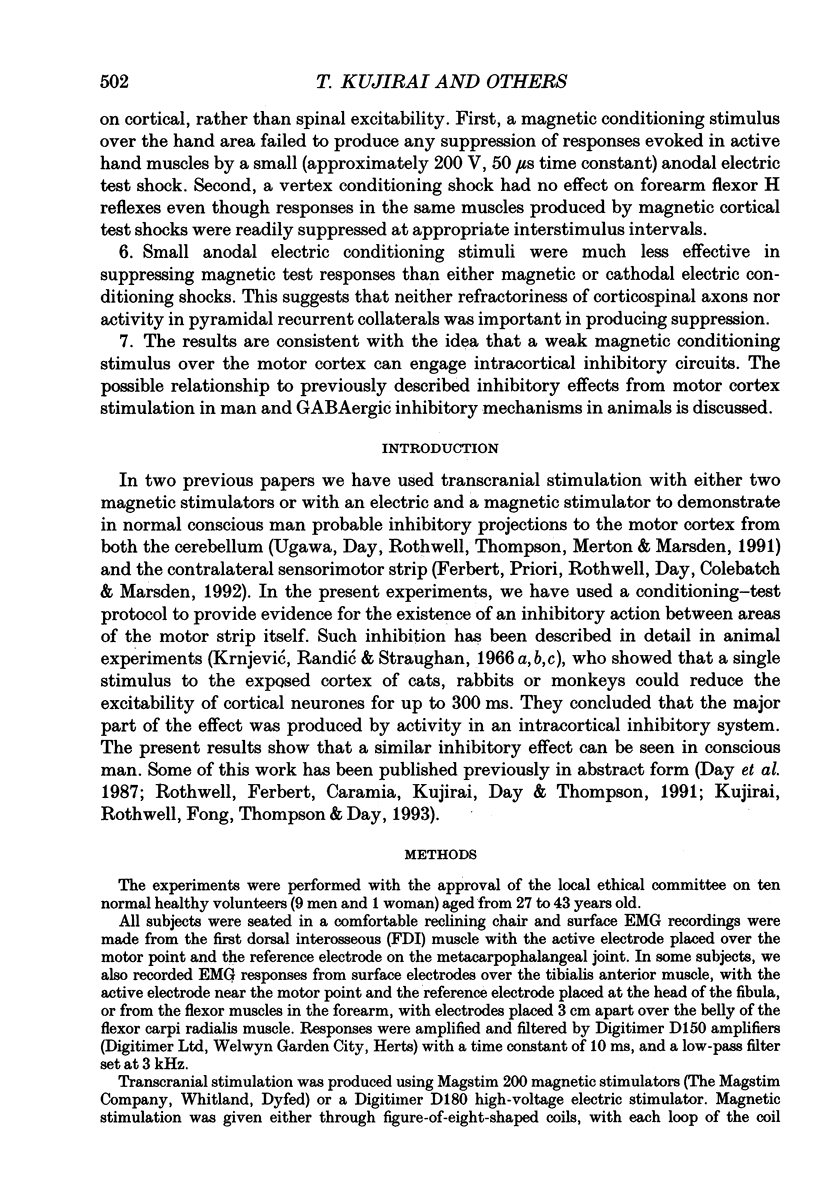
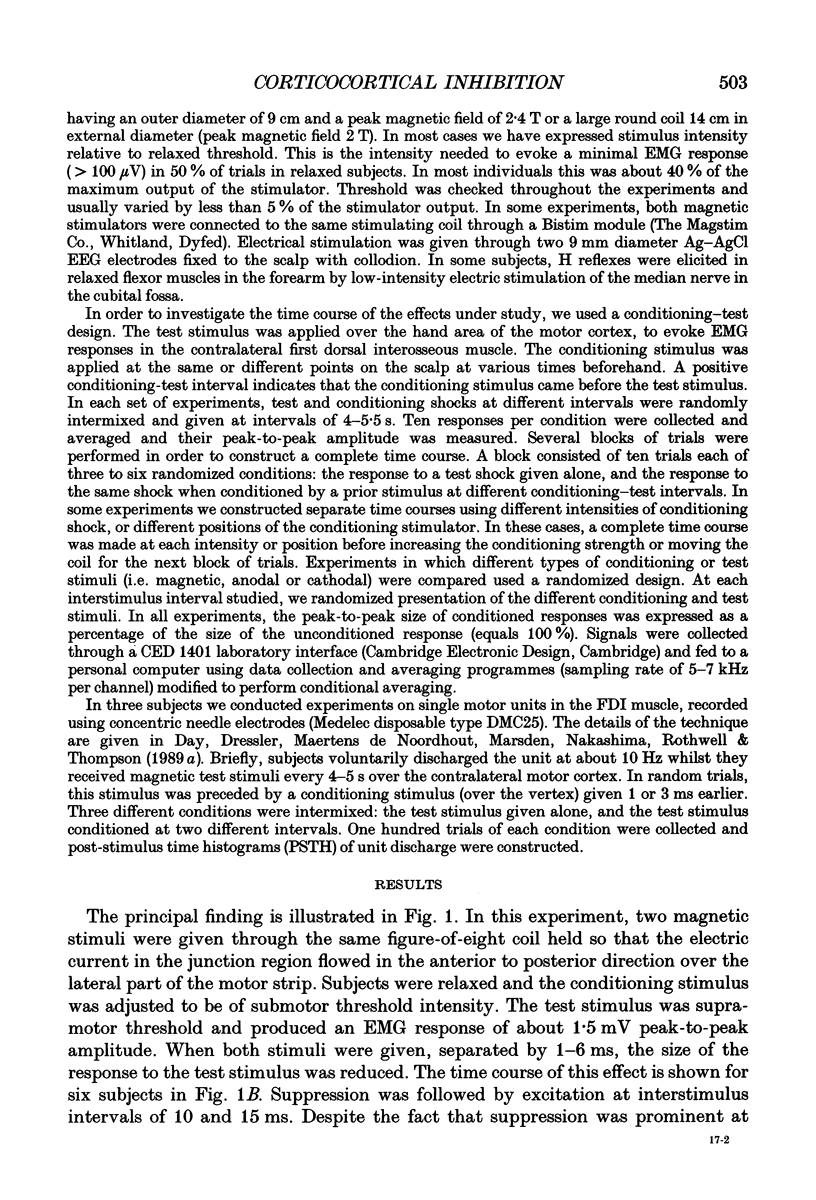
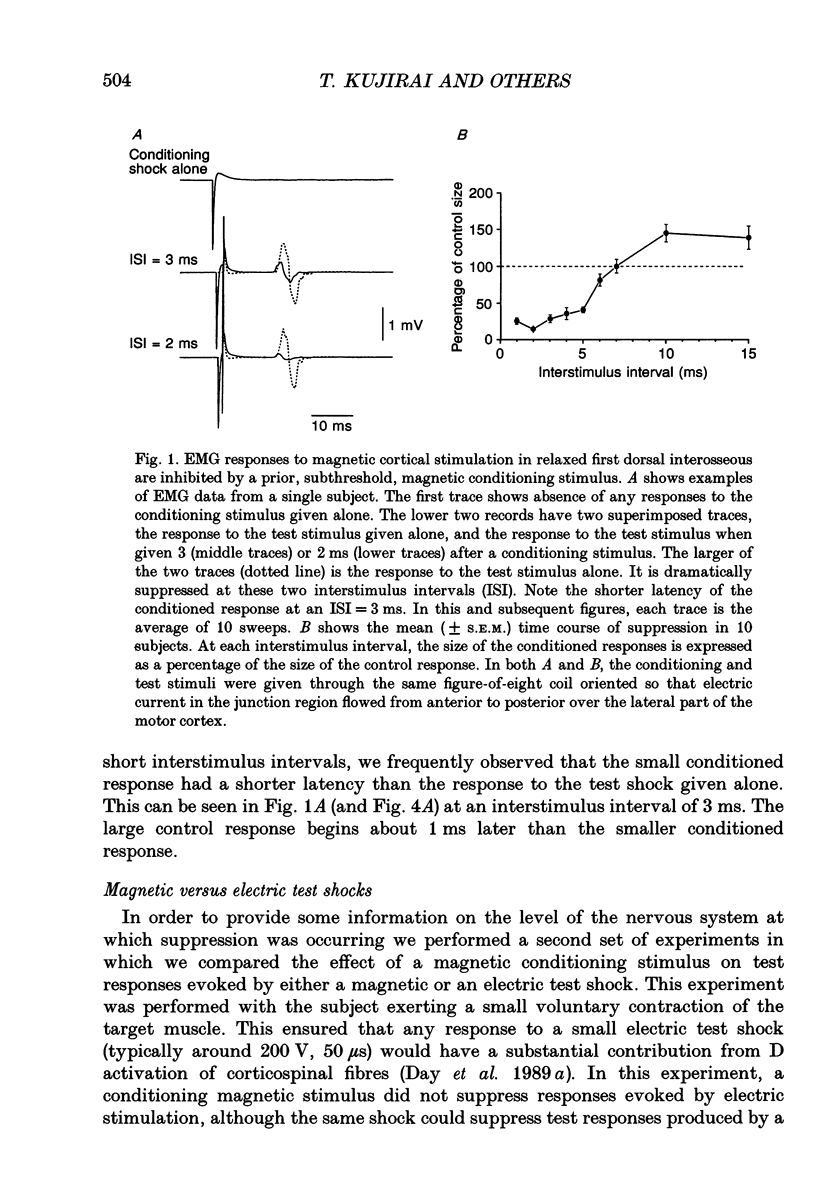
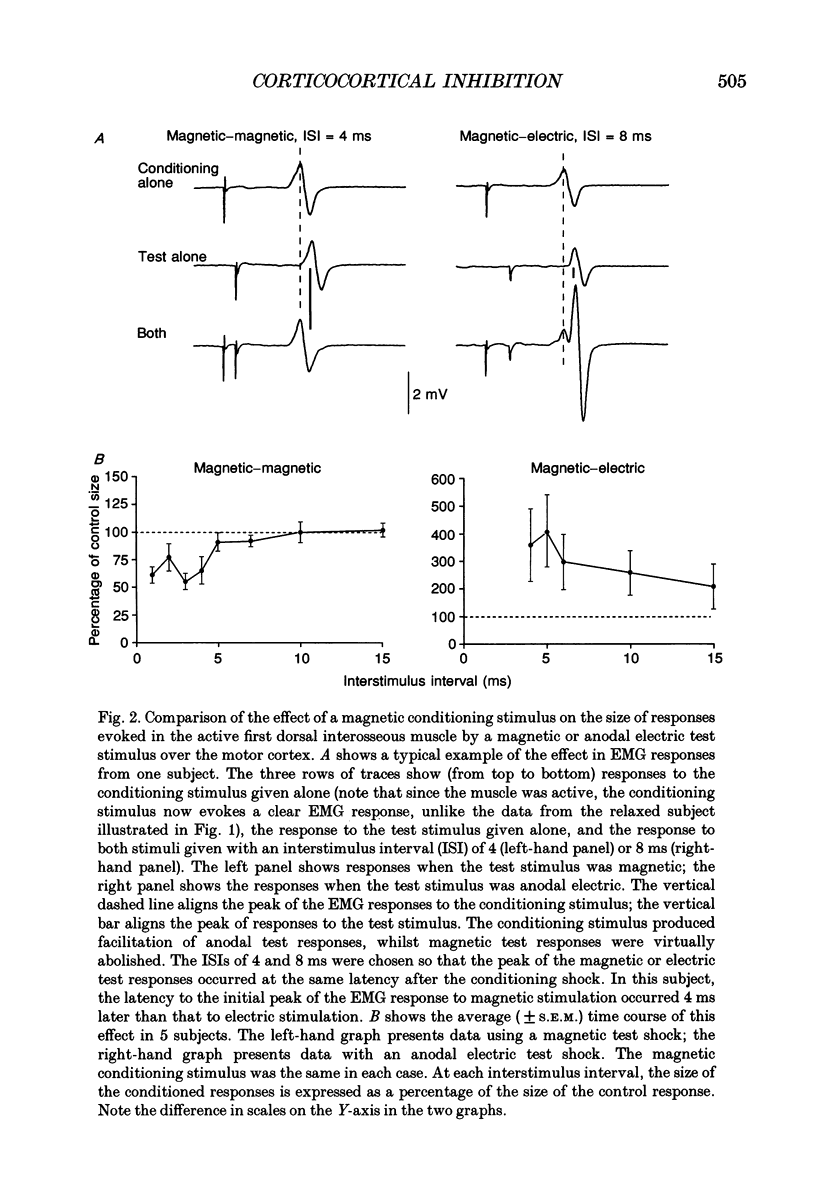
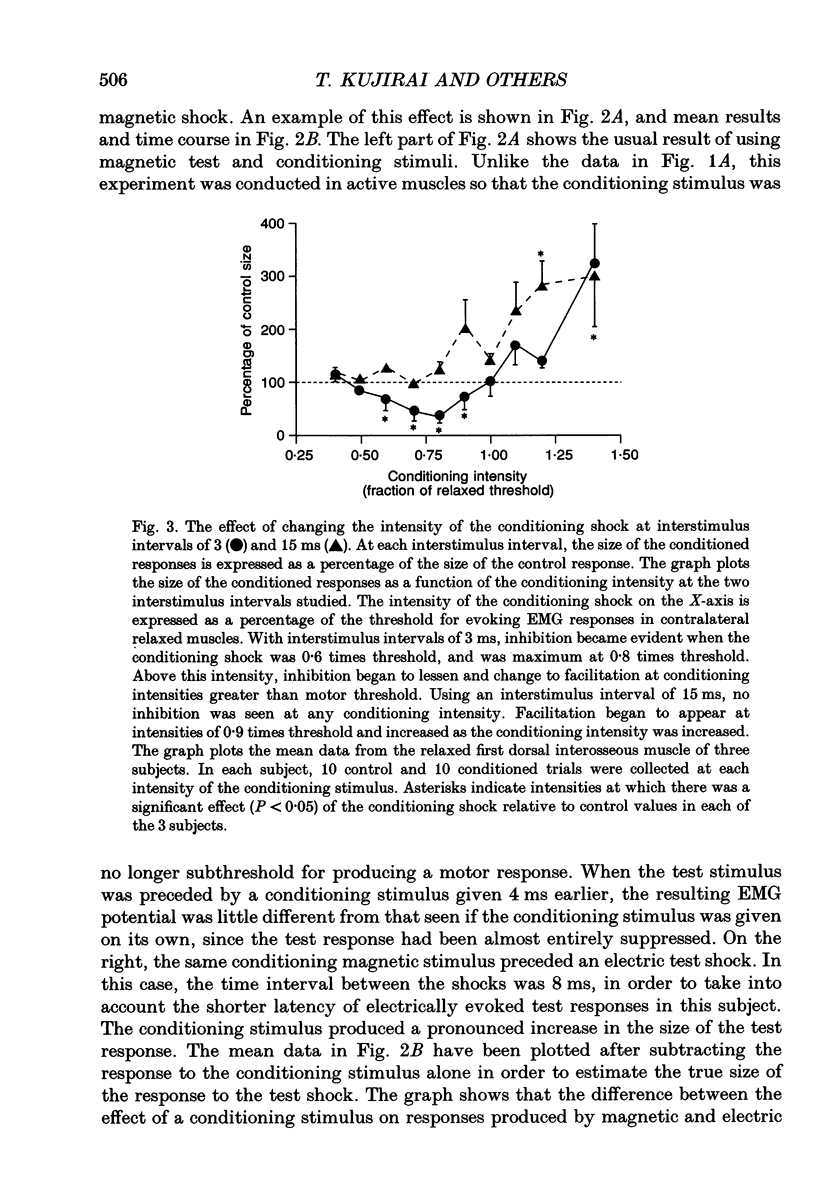
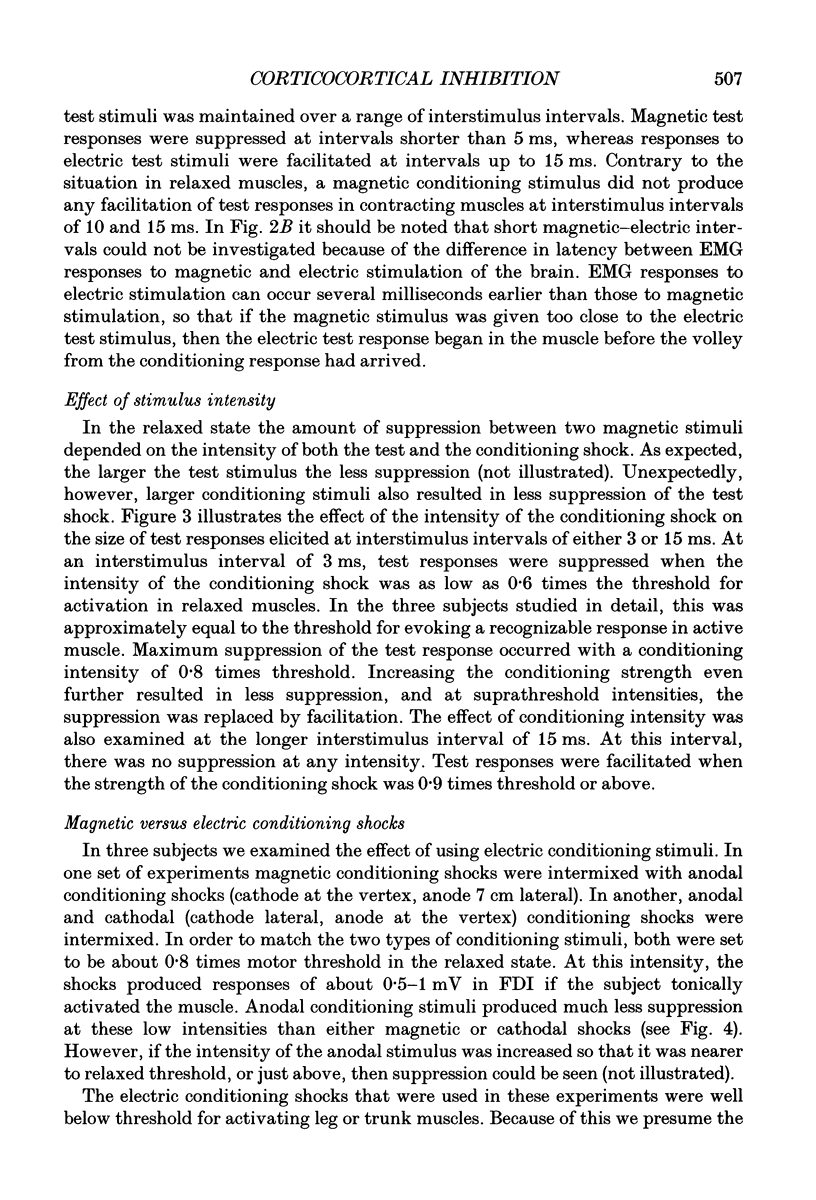
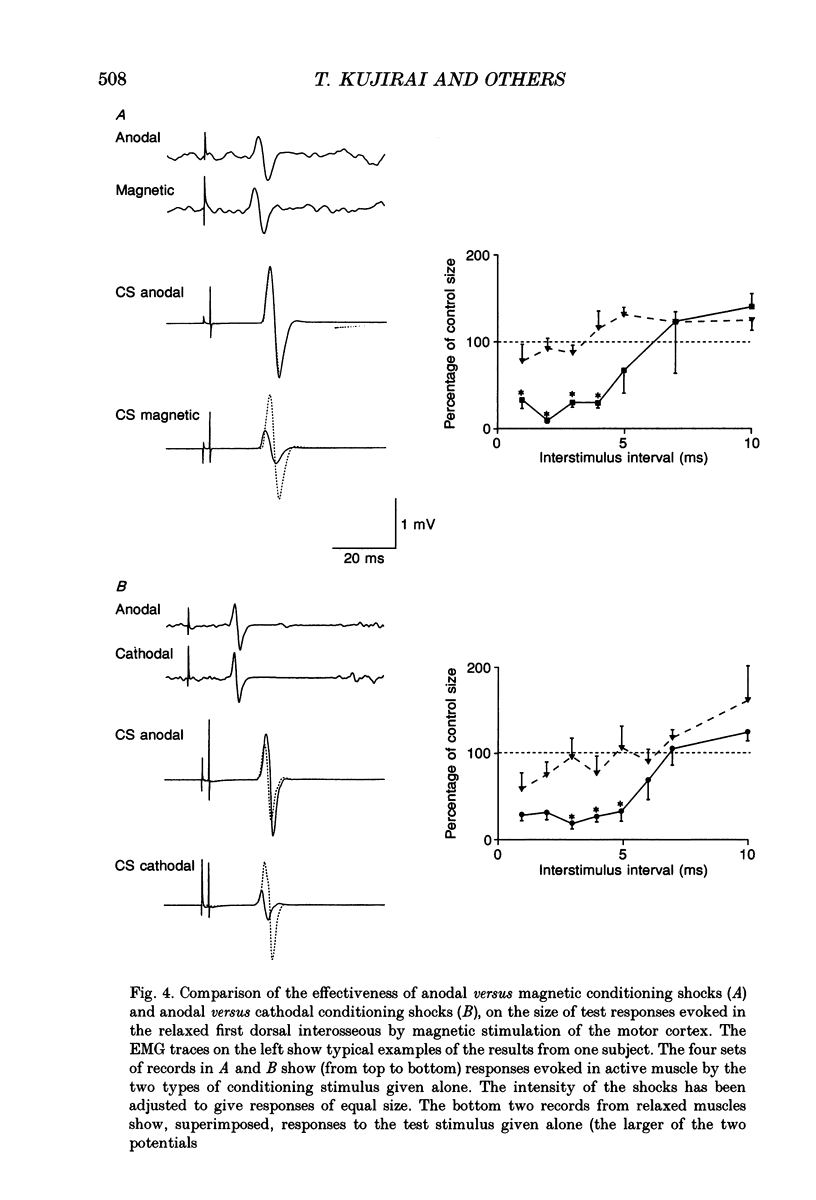
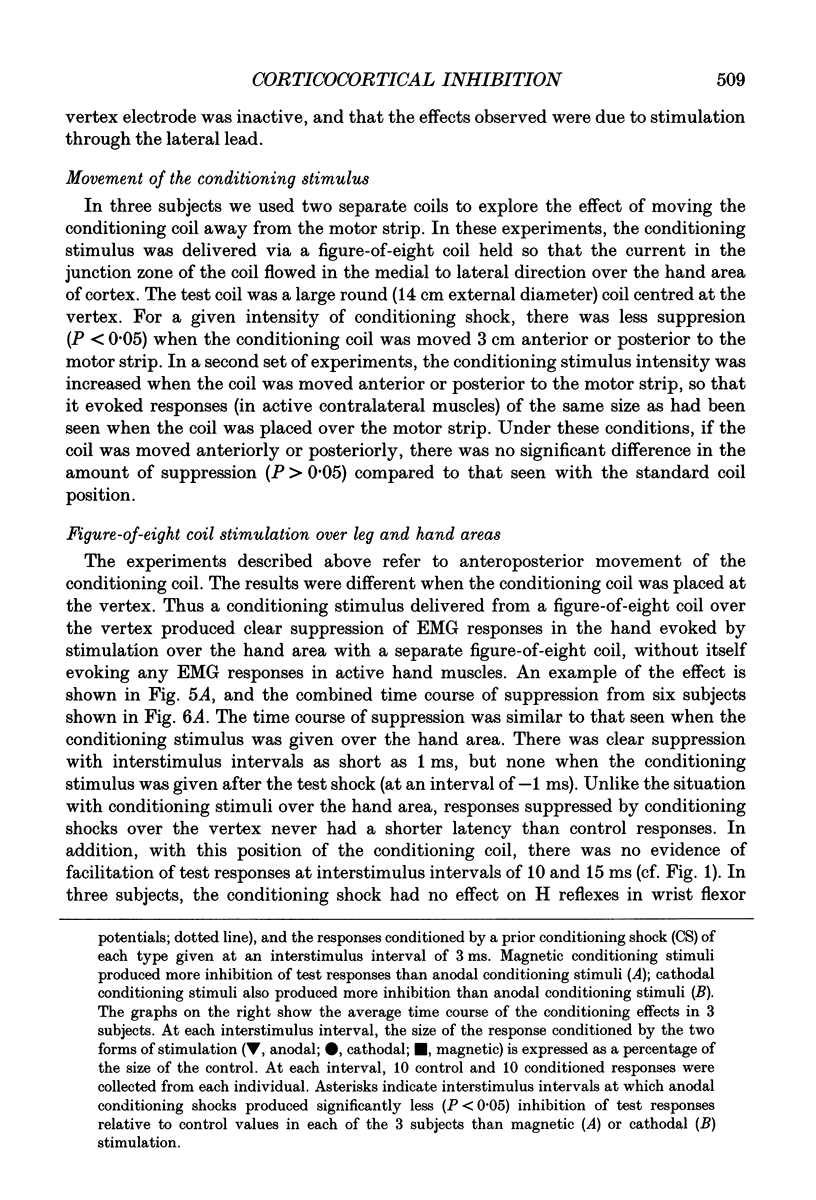
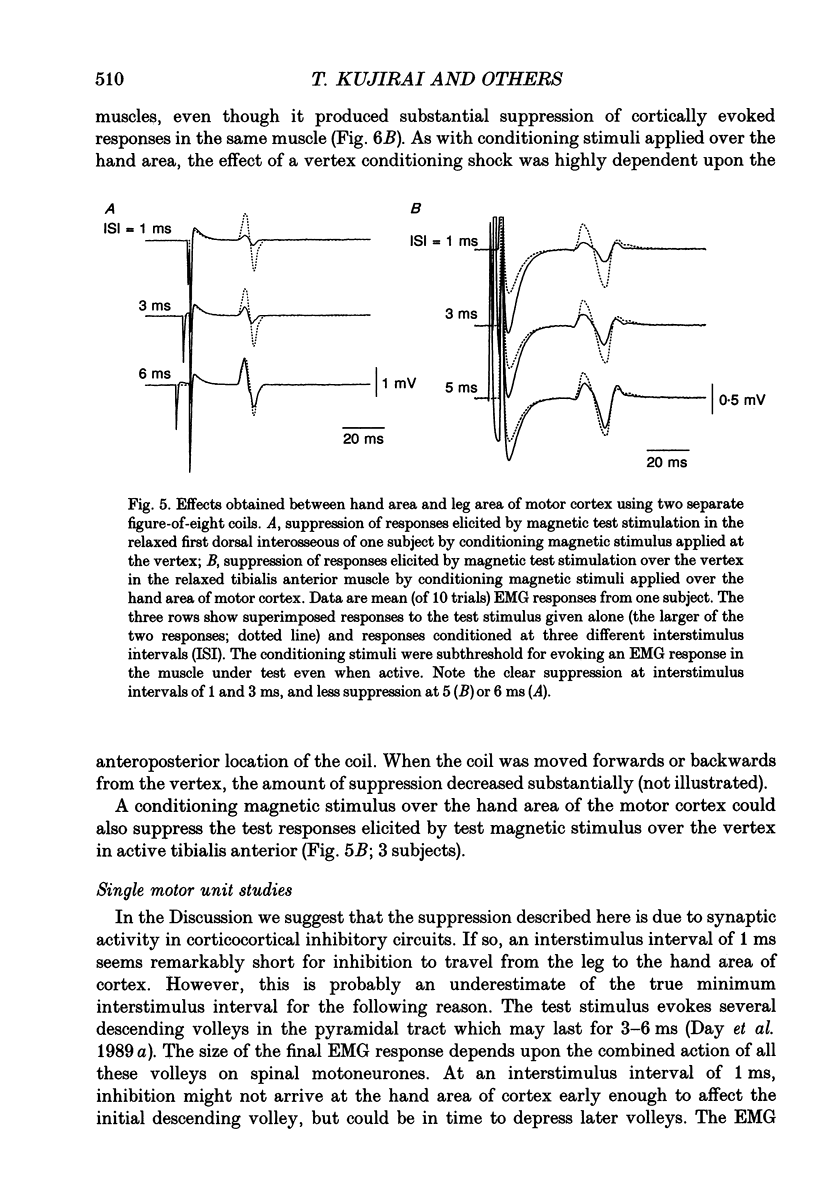
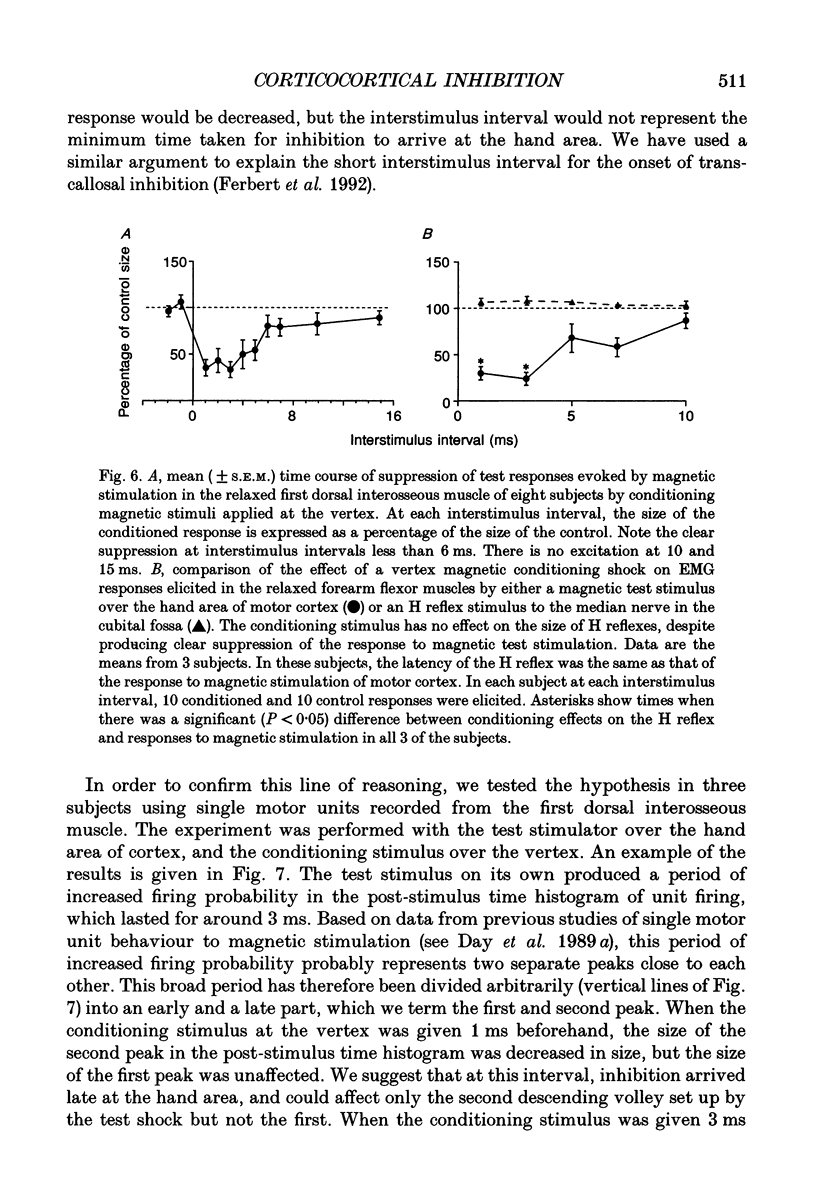
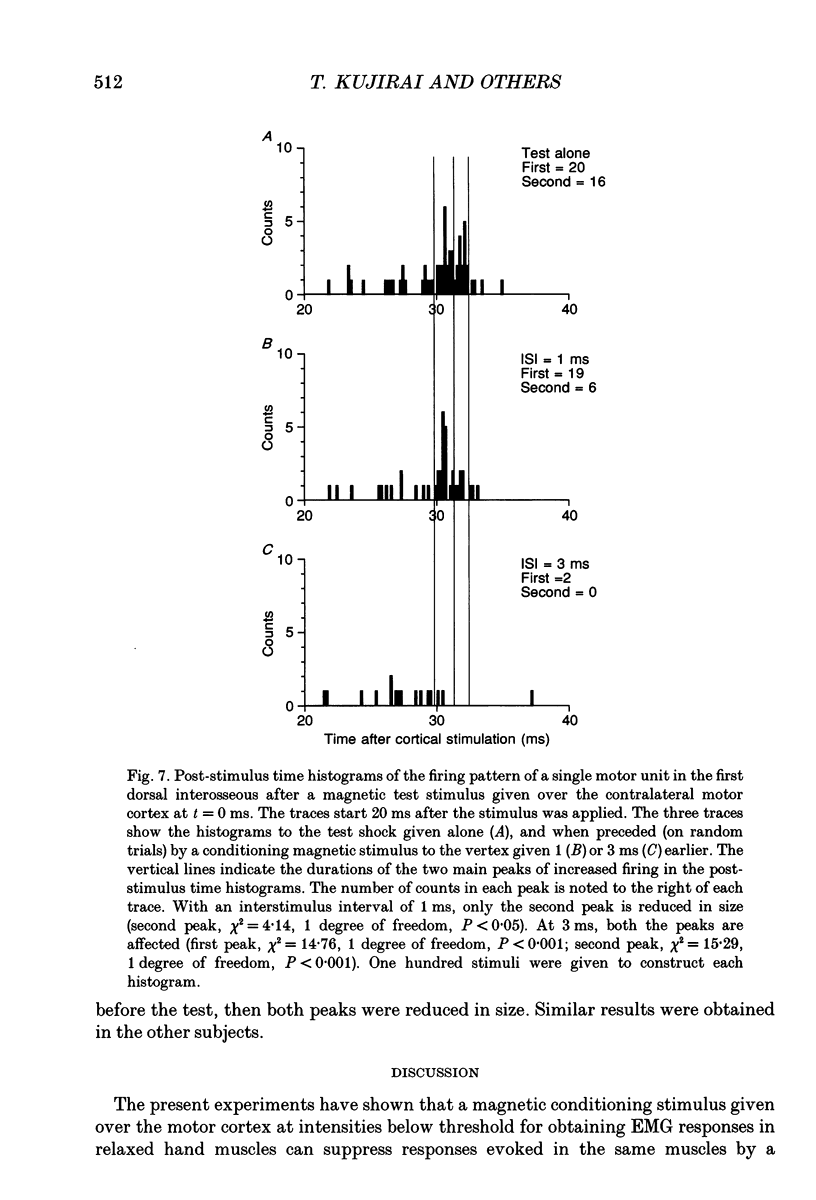
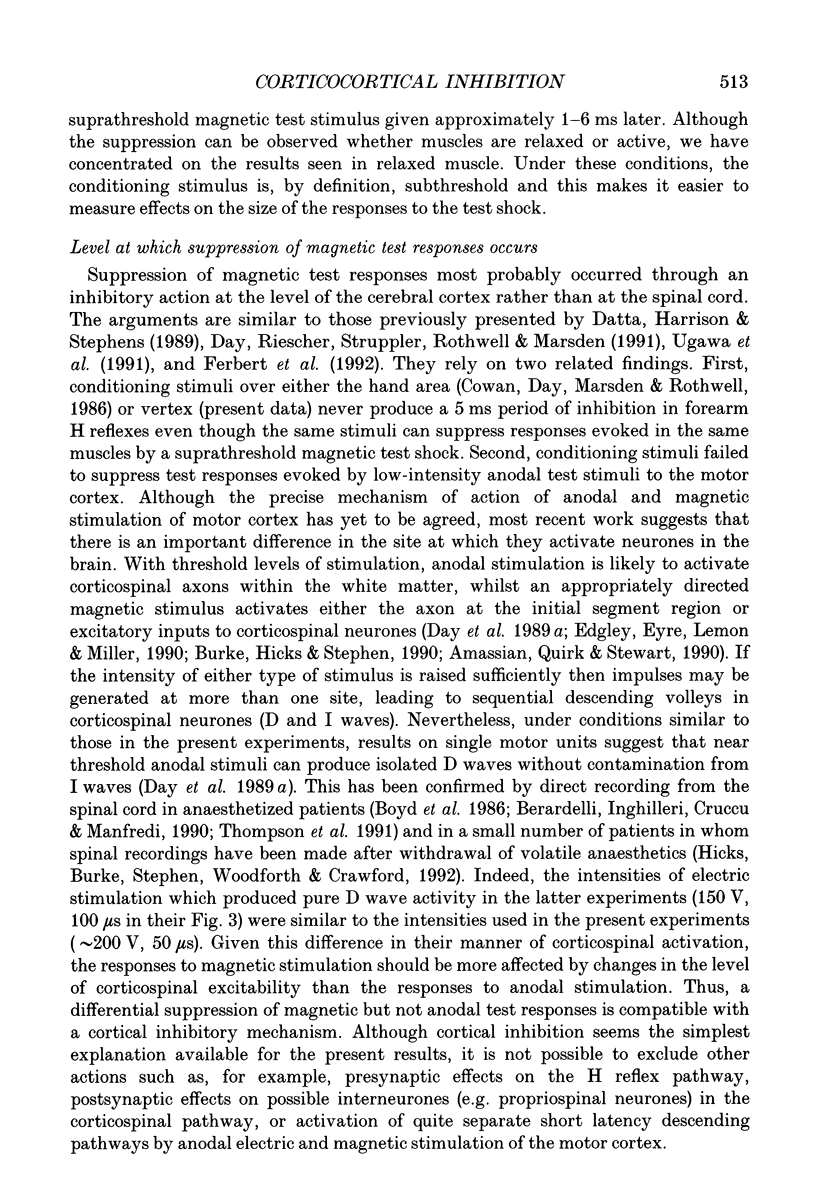
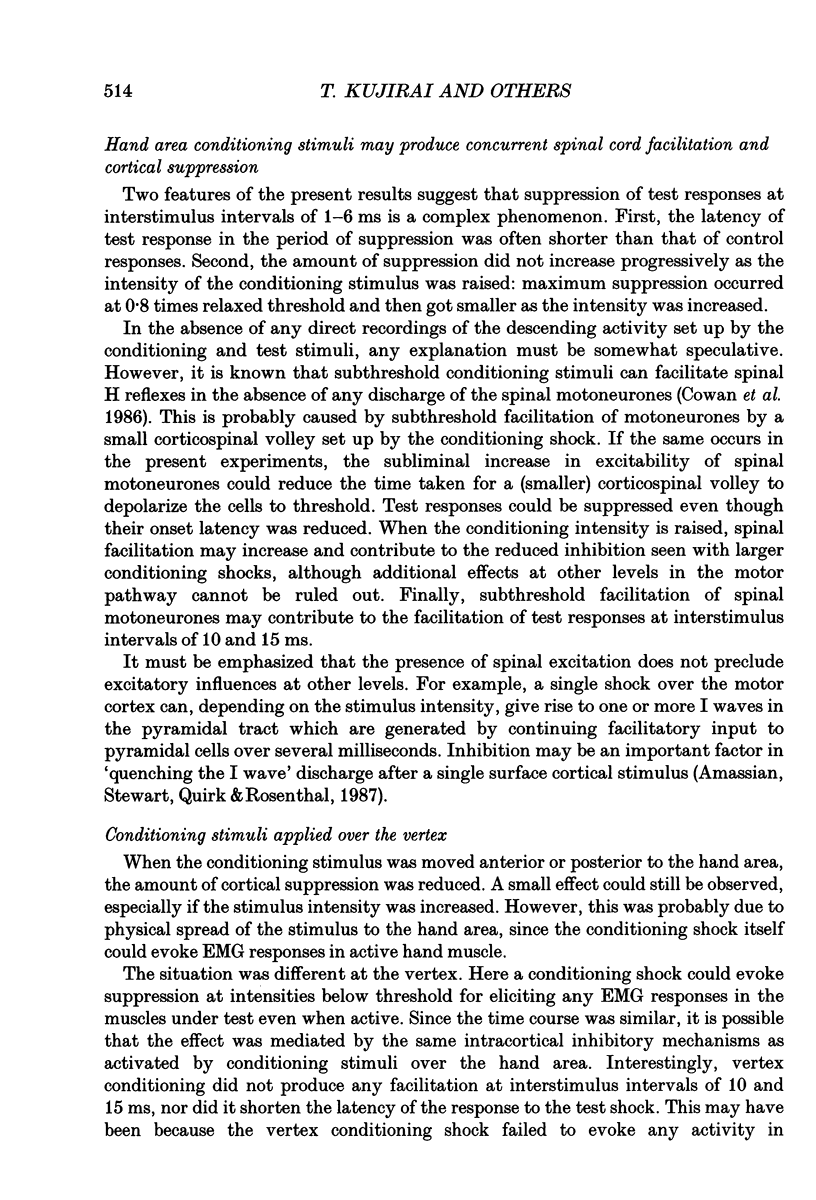
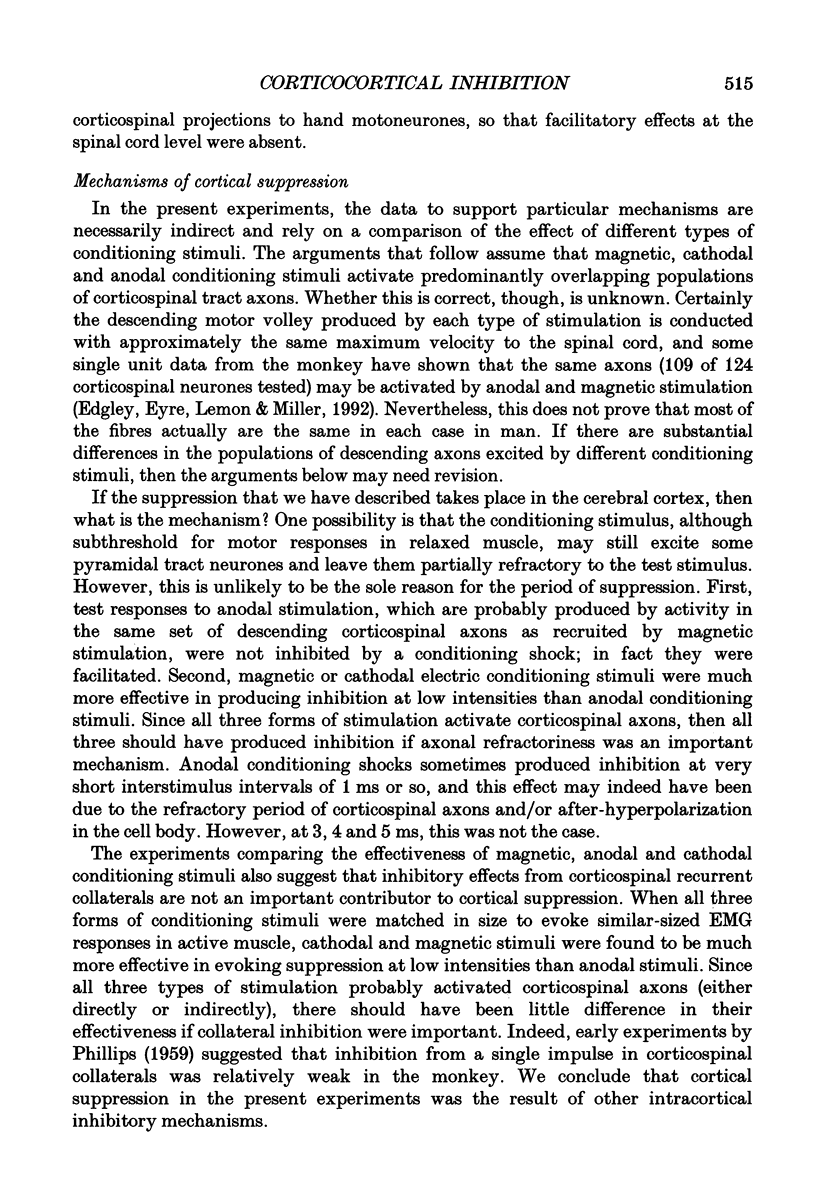
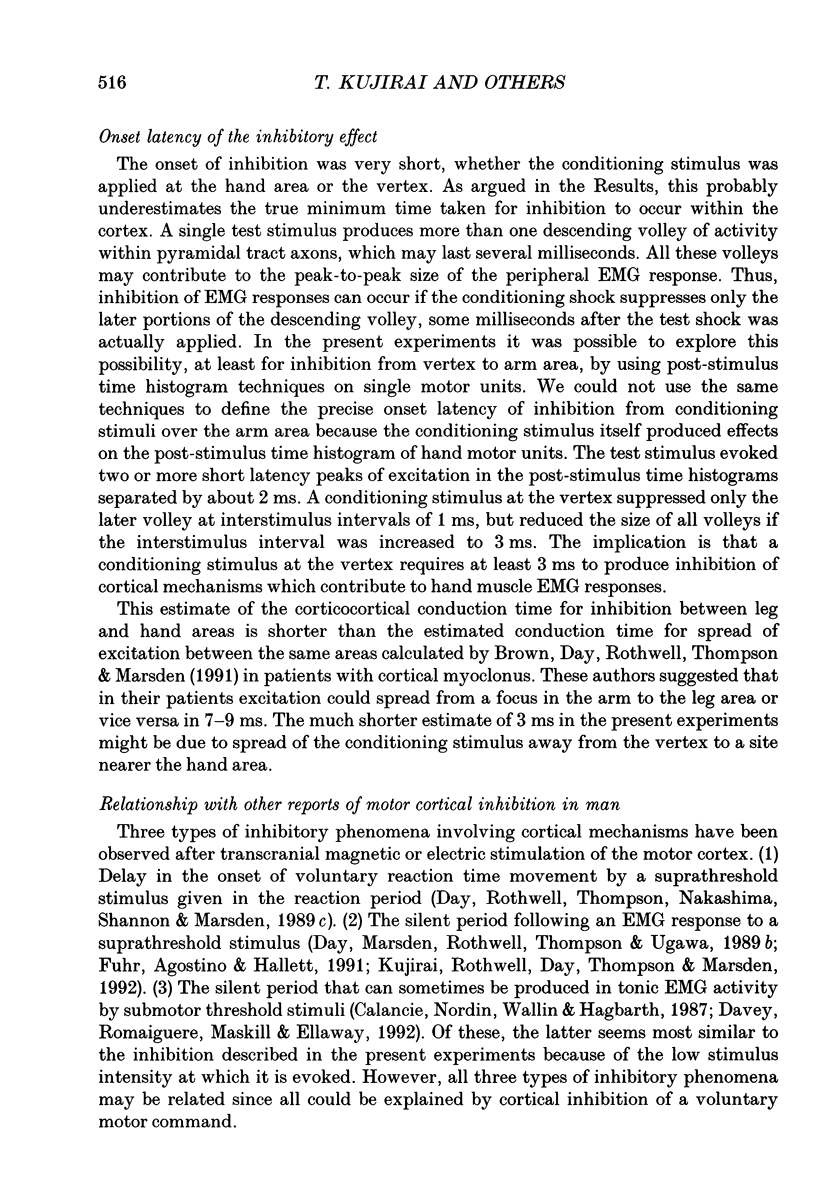
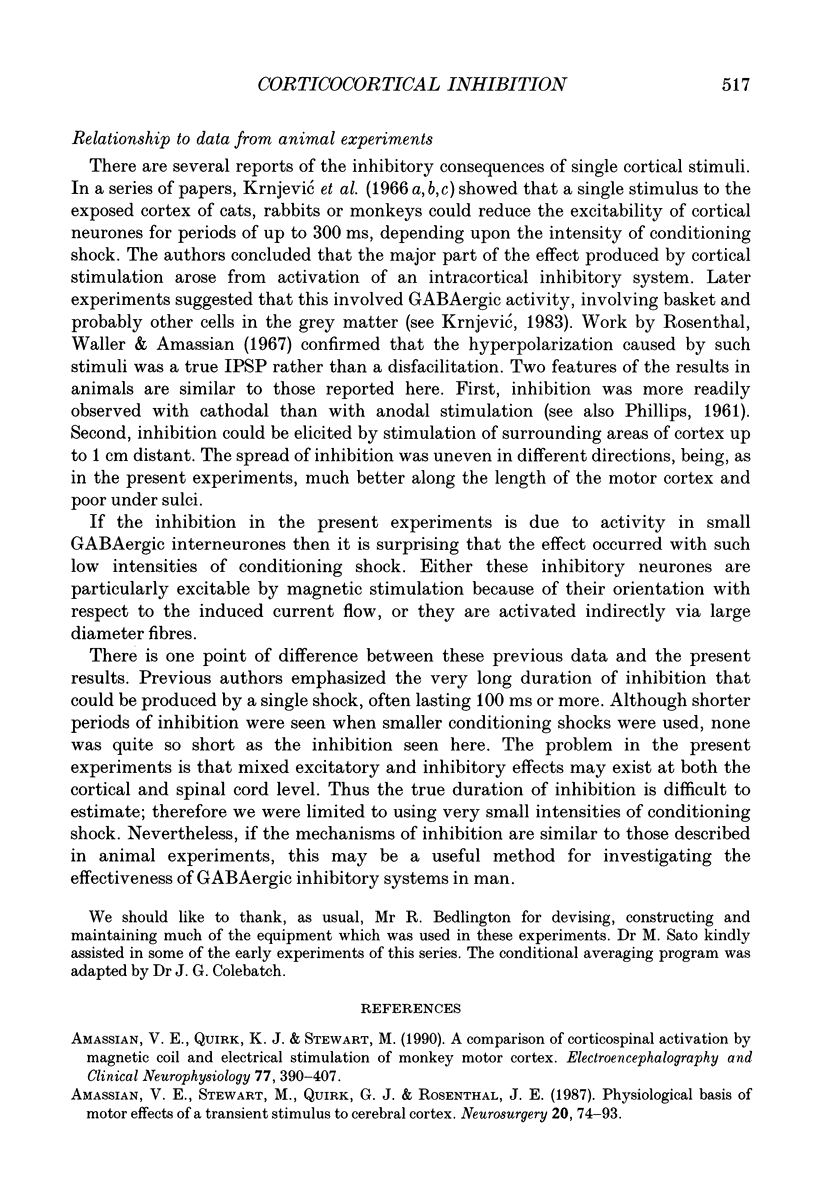
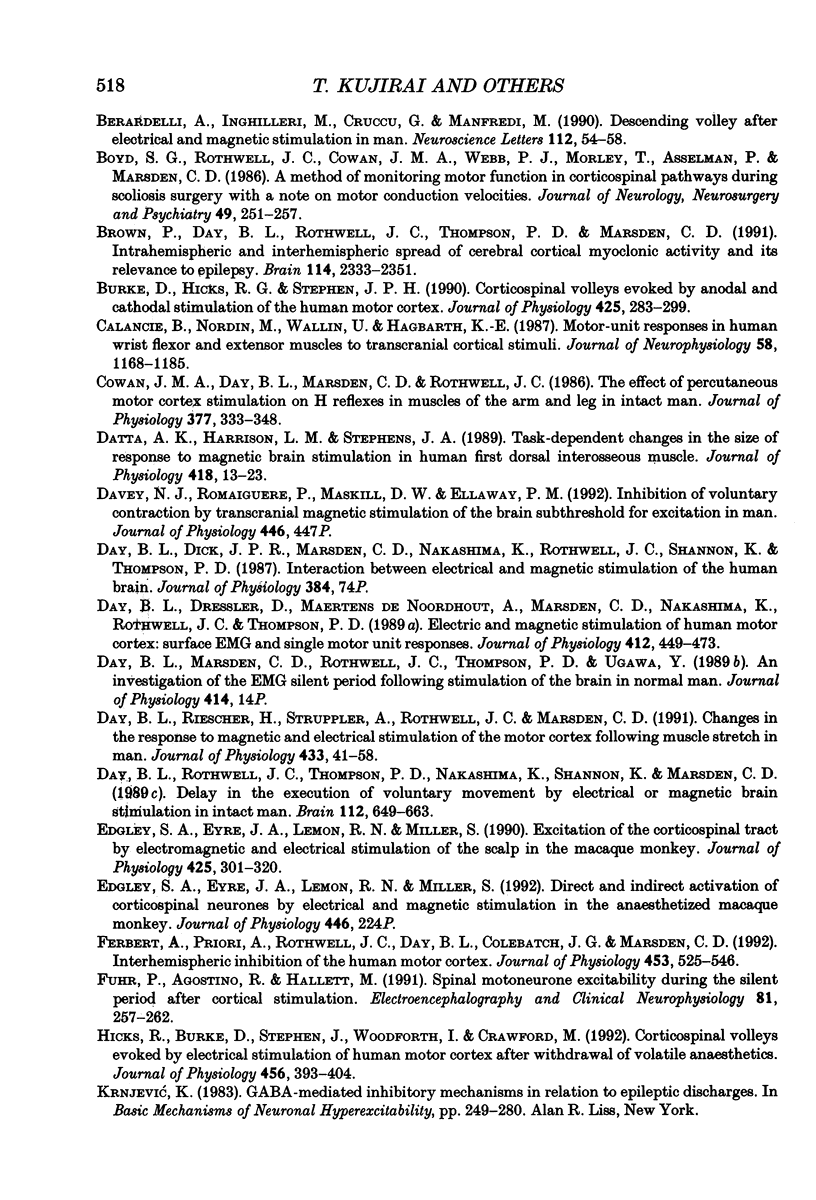
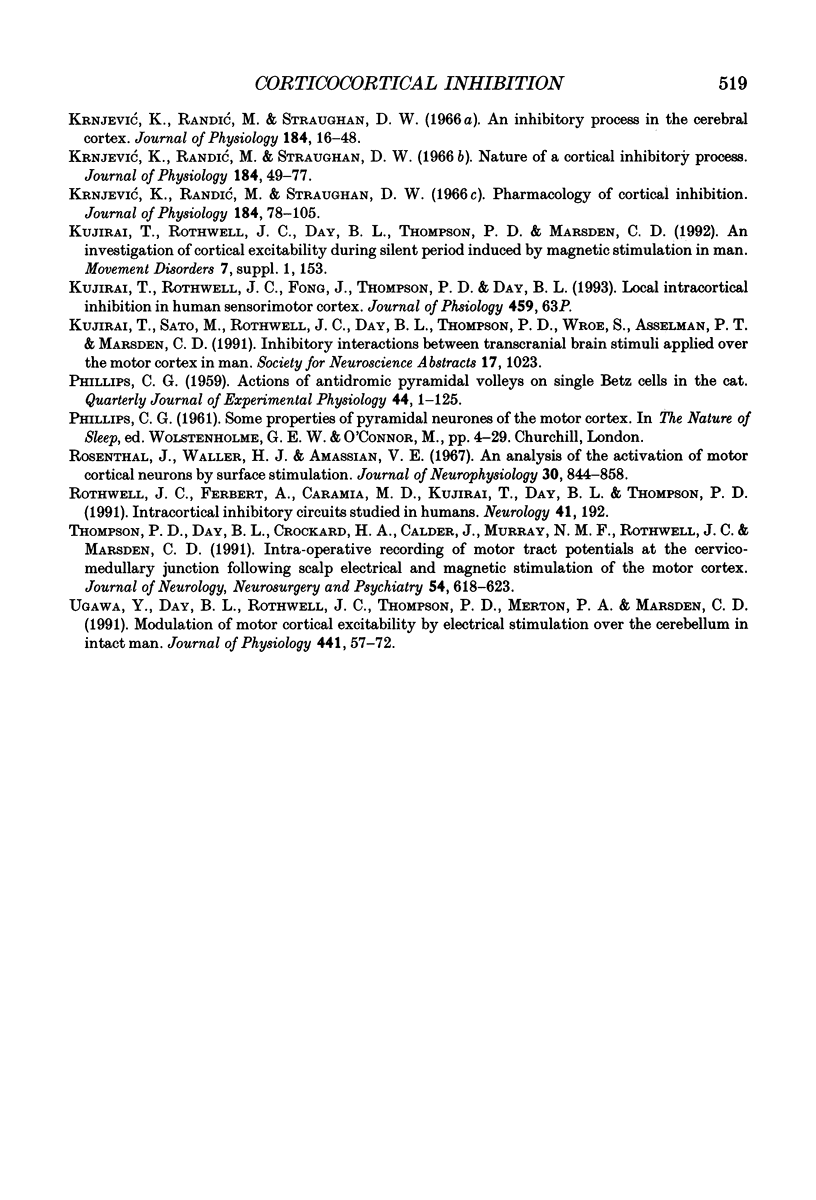
Selected References
These references are in PubMed. This may not be the complete list of references from this article.
- Amassian V. E., Quirk G. J., Stewart M. A comparison of corticospinal activation by magnetic coil and electrical stimulation of monkey motor cortex. Electroencephalogr Clin Neurophysiol. 1990 Sep-Oct;77(5):390–401. doi: 10.1016/0168-5597(90)90061-h. [DOI] [PubMed] [Google Scholar]
- Amassian V. E., Stewart M., Quirk G. J., Rosenthal J. L. Physiological basis of motor effects of a transient stimulus to cerebral cortex. Neurosurgery. 1987 Jan;20(1):74–93. [PubMed] [Google Scholar]
- Berardelli A., Inghilleri M., Cruccu G., Manfredi M. Descending volley after electrical and magnetic transcranial stimulation in man. Neurosci Lett. 1990 Apr 20;112(1):54–58. doi: 10.1016/0304-3940(90)90321-y. [DOI] [PubMed] [Google Scholar]
- Boyd S. G., Rothwell J. C., Cowan J. M., Webb P. J., Morley T., Asselman P., Marsden C. D. A method of monitoring function in corticospinal pathways during scoliosis surgery with a note on motor conduction velocities. J Neurol Neurosurg Psychiatry. 1986 Mar;49(3):251–257. doi: 10.1136/jnnp.49.3.251. [DOI] [PMC free article] [PubMed] [Google Scholar]
- Brown P., Day B. L., Rothwell J. C., Thompson P. D., Marsden C. D. Intrahemispheric and interhemispheric spread of cerebral cortical myoclonic activity and its relevance to epilepsy. Brain. 1991 Oct;114(Pt 5):2333–2351. doi: 10.1093/brain/114.5.2333. [DOI] [PubMed] [Google Scholar]
- Burke D., Hicks R. G., Stephen J. P. Corticospinal volleys evoked by anodal and cathodal stimulation of the human motor cortex. J Physiol. 1990 Jun;425:283–299. doi: 10.1113/jphysiol.1990.sp018103. [DOI] [PMC free article] [PubMed] [Google Scholar]
- Calancie B., Nordin M., Wallin U., Hagbarth K. E. Motor-unit responses in human wrist flexor and extensor muscles to transcranial cortical stimuli. J Neurophysiol. 1987 Nov;58(5):1168–1185. doi: 10.1152/jn.1987.58.5.1168. [DOI] [PubMed] [Google Scholar]
- Cowan J. M., Day B. L., Marsden C., Rothwell J. C. The effect of percutaneous motor cortex stimulation on H reflexes in muscles of the arm and leg in intact man. J Physiol. 1986 Aug;377:333–347. doi: 10.1113/jphysiol.1986.sp016190. [DOI] [PMC free article] [PubMed] [Google Scholar]
- Datta A. K., Harrison L. M., Stephens J. A. Task-dependent changes in the size of response to magnetic brain stimulation in human first dorsal interosseous muscle. J Physiol. 1989 Nov;418:13–23. doi: 10.1113/jphysiol.1989.sp017826. [DOI] [PMC free article] [PubMed] [Google Scholar]
- Day B. L., Dressler D., Maertens de Noordhout A., Marsden C. D., Nakashima K., Rothwell J. C., Thompson P. D. Electric and magnetic stimulation of human motor cortex: surface EMG and single motor unit responses. J Physiol. 1989 May;412:449–473. doi: 10.1113/jphysiol.1989.sp017626. [DOI] [PMC free article] [PubMed] [Google Scholar]
- Day B. L., Riescher H., Struppler A., Rothwell J. C., Marsden C. D. Changes in the response to magnetic and electrical stimulation of the motor cortex following muscle stretch in man. J Physiol. 1991 Feb;433:41–57. doi: 10.1113/jphysiol.1991.sp018413. [DOI] [PMC free article] [PubMed] [Google Scholar]
- Day B. L., Rothwell J. C., Thompson P. D., Maertens de Noordhout A., Nakashima K., Shannon K., Marsden C. D. Delay in the execution of voluntary movement by electrical or magnetic brain stimulation in intact man. Evidence for the storage of motor programs in the brain. Brain. 1989 Jun;112(Pt 3):649–663. doi: 10.1093/brain/112.3.649. [DOI] [PubMed] [Google Scholar]
- Edgley S. A., Eyre J. A., Lemon R. N., Miller S. Excitation of the corticospinal tract by electromagnetic and electrical stimulation of the scalp in the macaque monkey. J Physiol. 1990 Jun;425:301–320. doi: 10.1113/jphysiol.1990.sp018104. [DOI] [PMC free article] [PubMed] [Google Scholar]
- Ferbert A., Priori A., Rothwell J. C., Day B. L., Colebatch J. G., Marsden C. D. Interhemispheric inhibition of the human motor cortex. J Physiol. 1992;453:525–546. doi: 10.1113/jphysiol.1992.sp019243. [DOI] [PMC free article] [PubMed] [Google Scholar]
- Fuhr P., Agostino R., Hallett M. Spinal motor neuron excitability during the silent period after cortical stimulation. Electroencephalogr Clin Neurophysiol. 1991 Aug;81(4):257–262. doi: 10.1016/0168-5597(91)90011-l. [DOI] [PubMed] [Google Scholar]
- Hicks R., Burke D., Stephen J., Woodforth I., Crawford M. Corticospinal volleys evoked by electrical stimulation of human motor cortex after withdrawal of volatile anaesthetics. J Physiol. 1992 Oct;456:393–404. doi: 10.1113/jphysiol.1992.sp019342. [DOI] [PMC free article] [PubMed] [Google Scholar]
- Kaplan J. E., Litchfield B., Rouault C., Lairmore M. D., Luo C. C., Williams L., Brew B. J., Price R. W., Janssen R., Stoneburner R. HTLV-I-associated myelopathy associated with blood transfusion in the United States: epidemiologic and molecular evidence linking donor and recipient. Neurology. 1991 Feb;41(2 ):192–197. doi: 10.1212/wnl.41.2_part_1.192. [DOI] [PubMed] [Google Scholar]
- Krnjević K., Randić M., Straughan D. W. An inhibitory process in the cerebral cortex. J Physiol. 1966 May;184(1):16–48. doi: 10.1113/jphysiol.1966.sp007902. [DOI] [PMC free article] [PubMed] [Google Scholar]
- Krnjević K., Randić M., Straughan D. W. Nature of a cortical inhibitory process. J Physiol. 1966 May;184(1):49–77. doi: 10.1113/jphysiol.1966.sp007903. [DOI] [PMC free article] [PubMed] [Google Scholar]
- Krnjević K., Randić M., Straughan D. W. Pharmacology of cortical inhibition. J Physiol. 1966 May;184(1):78–105. doi: 10.1113/jphysiol.1966.sp007904. [DOI] [PMC free article] [PubMed] [Google Scholar]
- Rosenthal J., Waller H. J., Amassian V. E. An analysis of the activation of motor cortical neurons by surface stimulation. J Neurophysiol. 1967 Jul;30(4):844–858. doi: 10.1152/jn.1967.30.4.844. [DOI] [PubMed] [Google Scholar]
- Thompson P. D., Day B. L., Crockard H. A., Calder I., Murray N. M., Rothwell J. C., Marsden C. D. Intra-operative recording of motor tract potentials at the cervico-medullary junction following scalp electrical and magnetic stimulation of the motor cortex. J Neurol Neurosurg Psychiatry. 1991 Jul;54(7):618–623. doi: 10.1136/jnnp.54.7.618. [DOI] [PMC free article] [PubMed] [Google Scholar]
- Ugawa Y., Day B. L., Rothwell J. C., Thompson P. D., Merton P. A., Marsden C. D. Modulation of motor cortical excitability by electrical stimulation over the cerebellum in man. J Physiol. 1991 Sep;441:57–72. doi: 10.1113/jphysiol.1991.sp018738. [DOI] [PMC free article] [PubMed] [Google Scholar]


